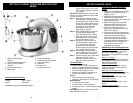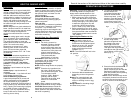
Fig. 1
1. Before using your mixer for the first
time, wash the beaters, dough hooks,
and bowl in warm, sudsy water. Rinse
and dry thoroughly. Use a damp cloth
to wash the mixer base. Dry with
a soft cloth. NEVER immerse the
mixer in water or any other liquids.
2. Before assembling your mixer, make
sure that the power cord is unplugged
from the electrical outlet and that the
On/Off beater speed control is at the
“Off” position.
1. Ensure that the mixer is not
plugged in to an electrical outlet
and that the On/Off beater speed
selector is on the “Off” position.
2. Press the mixer head release
button and tilt the mixer head
upwards. (Fig. 1)
NOTE: The mixer head will lock in the
‘tilt’ position.
Warning: To avoid injury when inserting
or removing beaters or dough hooks,
always set the speed selector to the
“Off” position and unplug the appliance.
Attaching the Beaters to the
Mixer
Mixer Head Release Button
HELPFUL BAKING HINTS
Ingredients
Raising Agents:
For best results pay attention to details.
Check for lumps and crush them if using
baking soda before measuring. Ensure
that yeast is fresh, and water is at the
right temperature.
Cheese and Breadcrumbs:
Pack grated cheese and soft bread-
crumbs into the cup pressing lightly to
obtain best results.
Fats and Oils:
The easiest way to measure ingredients
such as butter, margarine or shortening
is to place ½ cup of water into a
measuring cup then add margarine etc
until the water level raises to the amount
required minus the ½ cup water. Discard
water after measuring.
Helpful Hints for a Successful
Dough
Preparing the Yeast
Step 1: For the dry yeast to be
activated it needs to ferment.
To do this place warm milk,
sugar and the tepid water into
a bowl, add dry yeast and mix.
Let stand in a warm place until
mixture starts foaming, ie:
bubbles come to the surface.
This process will take
approximately 10 minutes.
WARNING: Ensure that you do not
overheat the milk or water as high
temperatures kill the yeast.
Preparing the Dough
NOTE: Ensure dough hooks are properly
in place.
Step 1: Place the dry ingredients into
the mixer’s bowl and position
onto the base locking the bowl.
Turn the speed control
switch to “LOW”. Begin to
gradually add the liquid
ingredients to the bowl while
mixer is on a low beater
speed.
NOTE: Using a spatula to scrape the
sides of the bowl while mixing is helpful.
CAUTION: Do not attempt to feed the
dough into the dough hooks with your
hands, spatula or any other utensil while
the mixer is operating.
Butter:
Butter is made up of approximately 80%
milk fat (cream) and is churned over time
to produce butter. Butter is a stabilizer
that also adds texture and flavor. Butter
comes salted or unsalted, it is best to use
unsalted for cake batters. Clarified butter
has the milk solids and salt removed
making it ideal for pastry making as it can
be heated to higher temperatures than
regular butter.
NOTE: Margarine is a good substitute for
butter. However because it is made from
vegetable oils it may alter the end results.
There is a variety of margarines to
choose from when diets are a concern.
Yeast:
Yeast is a raising agent used in doughs.
It is a microscopic living organism that
grows rapidly in warm, moist conditions.
The yeast plant feeds on sugar and
expels carbon dioxide which expands the
gluten. Do not allow the water
temperature to exceed 104 °F when
foaming yeast, as this will kill the live
yeast. It is best to foam yeast with
temperatures between 79°F - 86 °F that
are draft free.
Substitutes
If you need to substitute ingredients in a
recipe, check the following alternatives:
1 cup self raising flour = 1 cup plain
flour and 2 tsp baking powder
1 cup plain flour and 1 tsp baking
powder = ½ cup each of plain and self
raising flour.
Sultanas = equal measure of any other
dried fruit.
Golden Syrup = equal measure of
molasses.
1 cup buttermilk = 1 cup fresh milk and
2 tsp vinegar of lemon juice.
Hints for Measuring Ingredients
A good recipe depends on correct and
careful measurement of all ingredients.
All measurements of dry ingredients
should be “leveled off” (scrape surface of
a dry measuring cup with the flat end of a
knife). Tapping the measuring cup lightly
on a kitchen counter or table before
leveling. If your dry ingredients has any
lumps, make sure to remove or break
them up prior to mixing.
Read all the sections of this booklet and follow all the instructions carefully.
OPERATING INSTRUCTIONS
4. To insert the beaters: take
the two beaters, the
oval shaped beater (a) is
placed in the left socket,
of the mixer head, (outer
position). Place the beater
with the plastic scrapers (b)
a
on the base into the right
socket, (inner position). (Fig. 2)
b
a
b
NOTE: Ensure that the dough hooks
are properly inserted into the correct
sockets in the correct manner or your
mixer or hooks could be damaged.
b
a
Fig. 2
a
b
Fig. 3
6. Ensure that both the beaters or
dough hooks click firmly into
place, if required you can twist the
attachments slightly to engage
them into position prior to pushing
them into the sockets.
5. To insert the beaters: take
the two dough hooks,
place the dough hook with
the shorter hook at the
bottom (a) into the left
socket of the mixer head.
Then place the longer dough
hook (b) into the right socket
(inner position) of the mixer
head. (Fig. 3)
3. Select the desired attachments
depending on the mixing task at
hand:
Beaters-For creaming butter and
sugar, mixing cake and muffin
mixes or whisking cream or egg
whites.
Dough Hooks-For kneading dough,
and other heavy mixes.
6 3








